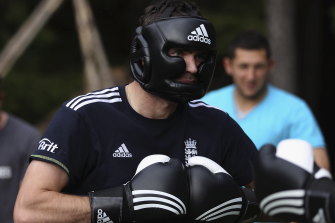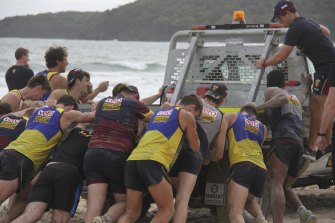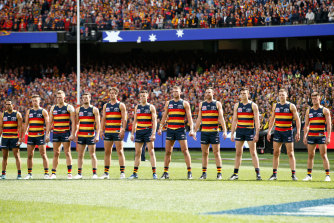How pre-season camps can work, and why Adelaide’s did not
By Daniel Brettig
It says much for the unchanging rhythms of football that, despite being 26 years apart, the two most famous pre-season camps in Adelaide Crows history each took place in the closing days of January.
In 1992 in Rapid Bay, the club was about to enter its second AFL season and searching for that something extra to go from a respectable 10 wins and mid-table to a finals berth. Reading an in-flight magazine some months earlier, All-Australian defender Nigel Smart thought he had found it.
Essendon Football Club draft players blindfolded during a camp in the Cann River region in 2003.Credit:Joe Armao
A motivational speaker and expert in firewalking, Paul Blackburn, would work the Crows into such a frenzy of self-belief that they could walk over hot coals for one another. It did not quite work out that way.
“People laugh at that but he actually walked across those hot coals,” the inaugural coach Graham Cornes has said. “He had a few blisters, that’s why we called it off because he looked uncomfortable.
“You’ve got no idea how hot those coals were. It was created from a big truckload of Mallee roots, a glowing, throbbing, pulsating, radiating mass of heat. By the time they scraped out a 10m by 1m area to walk on, the enthusiasm had waned a little bit.
“We laugh about it now, but it was a public relations disaster for the club.”
Why do sporting and corporate organisations run bonding camps?
One of the better explanations was delivered by Andy Flower, then England’s head coach, before he took the 2010-11 Ashes squad to Germany for a five-day slog in which the team led by Andrew Strauss was harried around the Bavarian forest by Australian police officers teed up through the team’s head of security Reg Dickason.
England fast bowler James Anderson suffered rib injuries in a sparring match at a pre-Ashes training camp in Germany.Credit:Getty Images
“It is designed to educate all of us, to give us a good sense of perspective on things, to allow the guys to become more self-aware, and allow the guys to understand each other better,” Flower said. “We can live in a cosseted world, in the sporting world, and this is there to broaden minds. It’s not related to the Ashes at all, it’s more about our development as a group of blokes.”
That trip did generate headlines, as the lithe England spearhead Jimmy Anderson suffered a fractured rib in a sparring match with his far burlier fellow opening bowler Chris Tremlett. On their subsequent triumph in Australia, however, players and staff did not recall the physical pummelling so much as relationships built at nightly campfires, away from mobile phones and other noise.
It may not have improved Anderson’s outswinger, but it helped engender a sense of unity when the cricket started – a similar recollection was shared this week by the former Australian wicketkeeper Adam Gilchrist about a similar exercise before the 2006-07 Ashes. Even vocal dissenters to that exercise, such as the late Shane Warne, were on board with it by the finish.
Neil Balme, a coach, mentor and football manager at Norwood, Melbourne, Collingwood, Geelong and Richmond, went on his first pre-season camp as a player with the Tigers in the summer of 1969-70. He recalls being told, by way of an incentive, “if you sign up with us you get to go on the camp!” They’ve been a part of the team-building kitbag ever since.
“You put them together so the players can figure each other out, and you as the coaches and administrators help that to happen,” he says. “Usually it’s to collaborate, to learn how the next bloke works, how you can help him and how he can help you. Those are the things that will make a difference during the season ultimately.”
After having their genesis with a football club’s own staff, facilitators of such camps have been drawn from far and wide. Psychologists, law enforcement or military types, outdoor experts. They have evolved in a few senses over the years.
Brisbane Lions players push a truck out of sand on their pre-season camp in 2014.
“All of us in elite team sport have been involved in a million camps – the motivation behind it is an admirable one,” former Collingwood and Brisbane Lions coach Leigh Matthews told Adelaide radio this week. “Way back in 1987, Collingwood, we’d finished second last and I was coach. We decided to have a tough experience together outside your general footy thing. It was in the Gippsland rainforest, and a couple of training guys from the SAS were running the camp.
“They were to be out there for three days, they carried everything they had. Very little communication with the outside world. And they got lost. We only knew this in retrospect, but because they had a genuine life-threatening experience, that ended up being a really bonding, positive influence on that group. You can never plan it to be that bad – it only went that bad because they got lost. But clubs do a lot of things trying to find that competitive advantage, and they can go wrong.”
Initially, physical strength and endurance training was the major part of the brief, particularly in the semi-professional era when a whole week with a group of players was seen as a luxury, away from day jobs and time constraints. They were also useful exercises for bringing along a camera crew to help promote how hard the club was working to bring success to its members that year.
“Back in the day it was a chance to make them run up a hill and all those sorts of things and have a day to recover rather than having to go to work the next day,” Balme says.
But as football and sport have become more thorough in physically preparing players year-round, increasing emphasis has been placed on the mental challenges presented. Overcome these obstacles, the brief often indicates, and opponents during the season will seem altogether more straightforward as a result.
Terry Wheeler, a forerunner in a few ways as a senior coach, aimed for that kind of gambit when he had Footscray players parachute into Port Phillip Bay ahead of the 1993 season. Secrecy, too, has often been a part of it – players whisked away to an undisclosed location, disoriented and challenged. Although as Balme reflects, secrecy in football generally relates to something else.
“Usually, secrecy is about doing something you shouldn’t be doing!” he laughs. “The secrecy is not necessary. We should be able to show everyone what we do and say ‘this is the way to do it’ and away you go.
“Sometimes secrecy in how you play is there, you don’t want to tell everyone how you play, but it’s pretty obvious how you do, they’ve only got to watch you. Quite often secrecy will be about covering up something they don’t want people to know because it’s not right, rather than because it is right.”
In Melbourne, the Storm’s “I Don’t Quit” camps – run by past and present members of Special Operations Group – built up such a reputation that they were co-opted by the Demons ahead of the 2017 season. That first, two-day camp covered familiar territory in terms of physically and mentally challenging players.
But when Dom Tyson hurt his knee and Christian Salem accidentally dropped a brick on his head, causing a concussion, players harboured enough concern to take the concept to the AFL Players’ Association when coach Simon Goodwin planned to undertake the same experience again ahead of 2018. Melbourne’s players, having fought for greater self-determination, would go on to a premiership.
That, of course, was the same summer in which the Crows undertook their own fateful camp in Queensland, after players had initially thought they were headed to the Gold Coast for swimming, some light training and time together to talk through the lost 2017 grand final.
What is now clear is that the camp devised for Adelaide was meant to go harder, reach further, and challenge more deeply than any pre-season camp had ever done before. It was going to push the envelope of resilience for a team that, only two years before, had forged through the unspeakable trauma of having their former head coach Phil Walsh murdered in mid-season.
Adelaide Crows players in the “power stance” as they line up for the 2017 grand final against Richmond.Credit:Getty
“Ego control can be part of the problem,” Balme says. “It should be about ‘what do the players need’, not making it bigger and better than last year. The camp won’t define your year for you, it’s how you play. There was a bit of ra-ra and ego sometimes about planning these things, but you’ve got to get past that, and if you do, you’ll make better decisions.”
Ironically, the evolution of men and athletes over the past 30 years has afforded greater openness and chances for connection without having to resort to the blunt instrument tactics that had previously been used to break down the egos and closed minds of their predecessors.
Samantha Graham, a mind coach who was instrumental to the success of the South Sydney Rabbitohs in 2014, has argued there is actually no need to push athletes to breaking point to find the vulnerability that brings honest conversations, connection between people, and ultimately better performance.
“That’s plenty of vulnerability right there for most groups of men, in my experience,” Graham told Good Weekend in 2018. “Take them out of their comfort zone, because that’s where learning happens. But you don’t want to take them into their terror zone, because it’s not productive or ethical.”
As for the Crows, Josh Jenkins pointed out in 2019 that the perspective behind the camp’s efforts to stretch the team was at a distance from the reality of a season in which the club had done everything but win the grand final.
“I think when you lose a final and even more so a grand final — and prelim finals as well — I think you need to remember that you’re one of the teams that need to improve the least, not the most,” Jenkins told SEN radio.
“We sort of went down a path of needing to change everything and we needed to rebuild ourselves as individuals and a team. That was clearly a mistake. That’s probably the main area we fell away.”
Says Balme of the mental side of the game: “It’s all ongoing, it’s day-to-day stuff. You can’t take a team away for a few days for an experience that changes everything, which is sometimes something I think we tried to do at those camps. Now it’s much more about the reality of how we prepare to play as well as we can for as long as we can.”
As Cornes rightly pointed out, the blisters suffered by Nigel Smart may not have looked good on television, but they were minor enough to allow him to play in the Crows’ next pre-season game five days later.
What’s less widely known about the whole episode is who called it off. Not Cornes, nor Smart, but the inaugural chairman of the Adelaide Football Club himself, Bob Hammond, who happened to be on-site. As a former player, coach and administrator of distinction, Hammond had a well-developed bullshit detector.
Senior oversight of events such as pre-season camps does in some ways appear to have been simpler in the days when clubs could number their staff by the tens, not the hundreds.
But in 2018, none of the chairman Rob Chapman, the chief executive Andrew Fagan, nor the football director Mark Ricciuto were present. The most senior men on the ground were the head coach, Don Pyke, and the head of football, Brett Burton. It’s not clear which camp exercises they participated in or witnessed.
In the four years since then, every club pre-season camp program has required sign-off by the AFL itself before going ahead, to ensure the mental and physical health of all involved. In any case, commando-style camps are out of vogue.
The camp was at the time rationalised as necessary to finding the competitive edge that would take the team to the top. The Crows have been walking on metaphorical hot coals ever since.
Keep up to date with the best AFL coverage in the country. Sign up for the Real Footy newsletter.
Most Viewed in Sport
Source: Read Full Article




